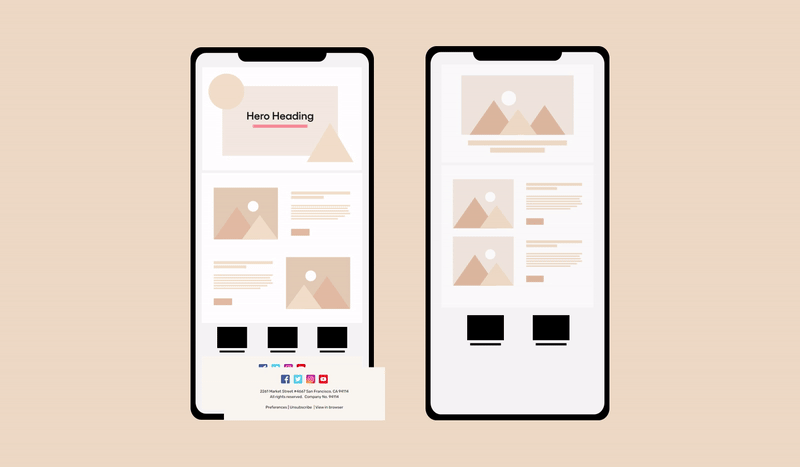There’s no denying that emails are one of the most effective ways for online promotions and marketing. Businesses engage with their customers and much more through this medium.
However, implementing email marketing isn’t that easy because you constantly have to experiment with what works and what doesn’t for your company. That’s why you need to know the difference between different types of emails.
Because not every email you send to your clients is for marketing purposes - case in point, transactional emails.
In this article, we’ll talk you through everything related to transactional email vs. marketing email, what these entail for you, and the success of your email campaigns.
So, let’s get started with the basic definitions.
Transactional Email vs. Marketing Email: What’s the Difference?
Let’s get down to business, define transactional and marketing emails, and see where the difference lies.
What is a transactional email?
Emails that are specifically triggered by your customer’s action are called transactional emails. For instance, a welcome email after someone signs up for your newsletter, an email receipt after a customer makes a purchase, and a comment notification all fall under the domain of transactional emails.
Plus, transactional emails are only sent to a few individuals rather than the whole email list.
What is a marketing email?
A marketing email is an email that lets you share new products, sales, and updates with people on your contact list. They contain the same content, more or less, and are not triggered by an event, for example, a weekly newsletter, a discount offer, etc.
Where the difference lies?
Some of the major differences between transactional and marketing emails are:
Transactional emails are triggered emails, and unlike marketing emails, are a basic necessity for many businesses like ecommerce, SaaS, and others. On the contrary, marketing emails are used for promoting products and services or nurturing leads.
Marketing emails often come in handy to boost engagement with your customers, so they contain information for various audience lists. However, the content of transactional emails is based on each individual customer’s action, like purchasing an item from your online store or completing a pending transaction, etc.
Why Separating Transactional Email From Marketing Email Is Important?
Separating transactional emails from marketing emails may feel daunting, but once you see the results, you’ll definitely invest more in separating the two.

Improves email deliverability
It’s all about deliverability when you’re dealing with time-sensitive emails such as password resets. Don’t get us wrong; promotional emails must also need to make it to your subscribers’ inboxes.
But it’s not always easy for email service providers to categorize your messages as such. So, by separating the two types of emails, you make it easier for them to sort your emails.
What we mean is if you employ the same servers and email address to send both a special discount offer and a password reset email, filtering systems of email service providers like Gmail may classify it as bulk email.
This, in turn, makes a dent in your sender's reputation. However, separating the two won’t jeopardize the deliverability of your critical transactional emails.
Reduces support requests
Delays in transactional emails result in more “Is my online order confirmed, haven’t got the order confirmation email yet” support messages. These messages mean more work for your customer support team and can damage customer relationships.
Therefore, you must separate transactional emails from marketing emails to reduce support requests and improve brand trust. This way, your recipients will promptly get a response after that password reset or an online order.
Types of Transactional Emails
Here are some of the most common types of transactional emails you can send to your subscribers.
1. Welcome email
When a person subscribes to your newsletter or creates an account on your website, it is critical to welcome them onboard quickly for a better user experience.
Here’s an example of what a welcome email can look like from Snow Days.

Related: 8 Incredible Welcome Email Examples for Inspiration (+Tips)
2. Order confirmation
People expect a confirmation email after making a purchase. This email should contain information regarding the ordered products, shipping address, expected delivery, etc., just like the below email from Haoma.

3. Cancellation notifications
A cancellation notification is a type of transactional email that is triggered when a user cancels their subscription, makes mistakes in the ordering process or simply doesn’t need the product anymore.
In any case, this email lets your customers know that their order has been canceled. Here’s an email example from Spotify.

4. Password resets
A transactional email that is triggered when a customer clicks on the “Forgot password” link is called a password reset email.
As we’ve all been locked out of accounts at some point in time, these password reset emails contain critical cybersecurity information specific to each user, making transactional emails the best choice.
Look at the below password reset email example from Patreon for inspiration.

5. Customer feedback requests
Customer feedback is essential for the growth of any business, but obtaining this might be tricky because customers are usually reluctant to fill out feedback forms. So, transactional emails are a great way to minimize the friction in the feedback process and save your precious time.
Need some inspiration? Check out the below email from Squarespace, efficiently seeking customer feedback.

Types of Marketing Emails
Using marketing emails to keep in touch with your customer base is crucial for your business. There are various types of marketing emails, and some of the most common ones are:
1. Newsletters
All kinds of businesses send out newsletters to their subscribers to stay at the top of their minds. This type of marketing email is often used to send out new content like blog posts or general news about your company.
Email newsletters don’t have to be flashy or anything, and Parsley Health knows exactly how to use minimalist design to make the email for their recipients easy to read, scan, and click.

2. Promotional emails/discounts
If you want to promote your upcoming sale or a special coupon code, promotional emails are the best option. These emails are quite popular with ecommerce businesses who want to upscale their Black Friday, back-to-school, or Cyber Monday email campaigns—just like Art of Play proves with their special offer email.

3. Lead nurturing emails
From ecommerce to product marketing, lead nurturing emails always come in handy. It’s a way to stay connected with the leads that you’ve collected along the way but aren’t ready to buy from you yet.
And it can build up trust until they’re ready. Check out this email example from Airbnb, which is committed to giving its readers wanderlust without seeming pushy.

4. Re-engagement emails
With a whopping number of emails hitting your subscribers’ inboxes every day, it’s inevitable that a percentage of your subscribers may stop engaging with your email campaigns.
And this bunch of unengaged subscribers can negatively impact your sender's reputation. Before completely removing them from your email list, you can win them back with a re-engagement email campaign—just like Mint does with the below email encouraging its subscribers to revisit their website.

Transactional Email vs. Marketing Email: Which Performs Better?
Typically, transactional emails have higher engagement rates as compared to marketing emails.
Why?
Because transactional emails include vital information like the order number, order confirmation, expected delivery dates, etc., which is something very valuable to customers. Since they’re usually anticipating this email, transactional emails tend to have higher engagement rates.
Wrap Up
There are some critical differences between transactional and marketing emails, and each serves different purposes. However, they still work in harmony and are part of the same mechanism - email marketing.
This means that you need to employ both at different stages of the buyer journey to get the best results.
Hopefully, the above comparison between transactional email vs. marketing email proves to be helpful for you.





